TOMATOES CARE TIPS, BASICS & LIST
Tomatoes are here! CAUTION! Wait for nighttime temps to be above 50 degrees (F) before planting outside without protection to avoid cold damage and poor fruit production.
Tomato Basics
WHAT DO HEIRLOOM, OPEN POLLINATED & HYBRID MEAN?
Many of the varieties we carry are 'heirlooms,' or classics developed before about 1950. Heirlooms come in all shapes, sizes, and colors. All heirlooms are 'open-pollinated,' which means they are non-hybrid. This means seeds saved from these plants will grow up to be like their parents, given that there are no other tomato varieties in the area to cross pollinate with.
Beyond that, you will see varieties labelled 'hybrid'. Hybrids are not the same as genetically modified organisms, or GMOs. Hybrids are created from the cross-pollination of two or more varieties. They are bred and selected for the best characteristics of their parents, and are known for vigor, high yields, and disease resistance as well as flavor and appearance. However, if you save seeds from a hybrid, you never know what the resulting plants will be like.
We also carry 'heirloom marriages,' which are hybrids with heirloom parents. The best of both worlds!
GROWTH HABIT: HOW TALL WILL MY TOMATO PLANT BE?
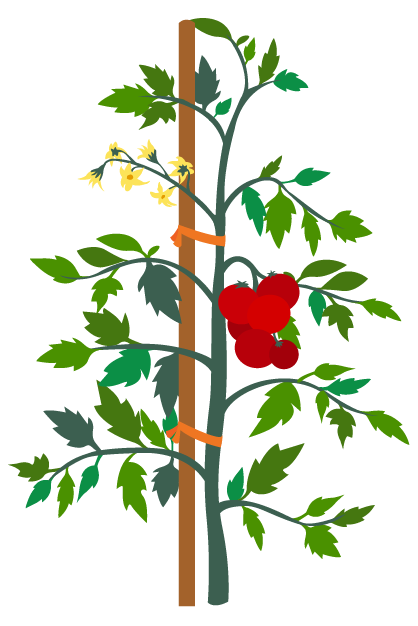
Indeterminate
Indeterminate (Indet) tomatoes can grow to over 7’ tall, are often pruned and trellised, and will produce steadily all season, along the whole length of the vine, until frost. These will grow better in the ground or a raised bed. (All grafted tomatoes are indeterminate.)
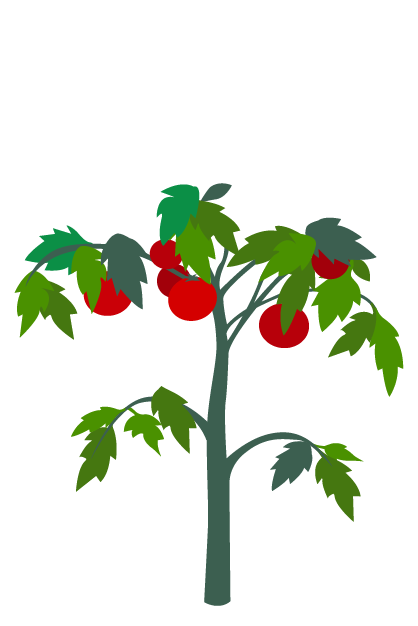
Determinate
Determinate (Det) tomatoes are compact and produce one harvest within a relatively small window of time that sets at the top of the vine. They should not be pruned. These are ideal for containers and may require only a simple cage to keep them upright and support the fruit.
Semi-Determinate (Semi Det) varieties are compact, but still produce over a longer period of time. They will benefit from support, but will not grow indefinitely.
55-90 Days
DAYS TO MATURITY: HOW LONG UNTIL I CAN EAT THEM?
The number of days to maturity for each variety in the list below is an estimate of how long it will take for your tomato to produce a harvest. Fewer days means an earlier harvest and better likelihood of success in our PNW climate, but some of the most flavorful varieties need longer to mature and are worth exploring. The days to harvest are clearly marked on all our in-store signs as well.
UNDERSTANDING TOMATO TYPES FOUND AT SKY
Our tomatoes are broken up into four main categories, and you will find them organized this way when you come in to shop. You can use this information to choose the best tomato for your preferences and space from the list below.
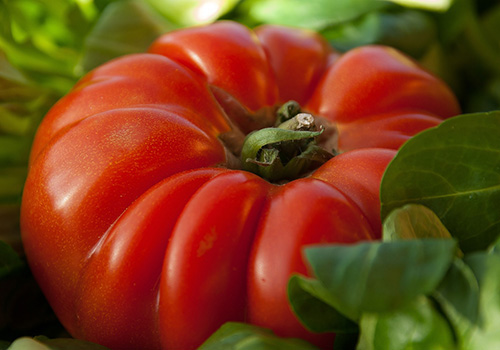
SLICING, BEEFSTEAK
These are our largest, meatiest tomatoes. Fruit from these plants averages 12-16 ounces (about the size of a grapefruit) depending on the variety, and they generally have more flesh than juice or seeds. They are especially popular for sandwiches and burgers, but are equally delicious in a salad and can even make excellent tomato sauce.
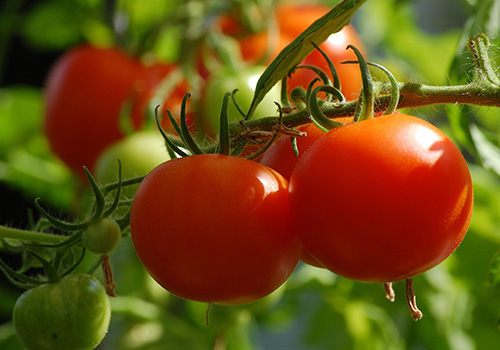
SLICING, SALAD & GLOBE
These classic salad tomatoes range from golfball-size to baseball-size and are full of juicy flavor. While some of the tomatoes in this section are more juicy and others are more meaty, they are all the ideal size for slicing up into a summer salad. Or, you could just eat them fresh from the vine, we won't judge!
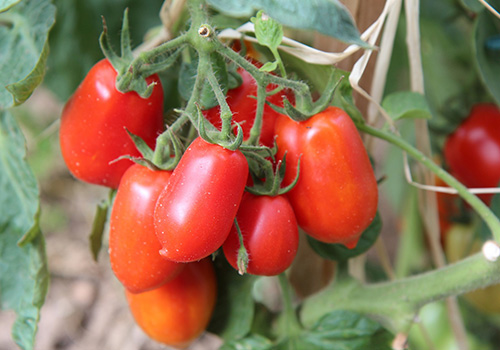
SAUCE & PASTE
While nothing is stopping you from eating these tasty tomatoes fresh, they are prized for cooking and drying because of their dense flesh and relatively small amounts of juice and seeds. This includes both oblong "roma" types as well as heart-shaped "oxhearts."
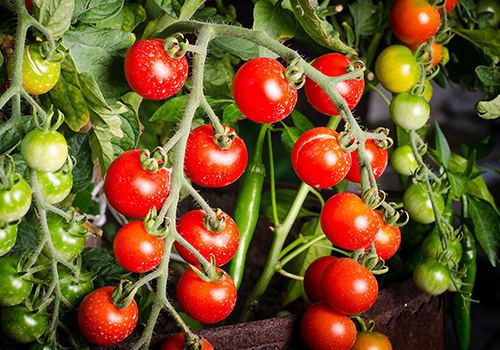
CHERRY, GRAPE & CURRANT
Caring for Tomatoes
Tomatoes can be simple and incredibly rewarding to grow. Click below to find out more about how to care for them, for a healthy plant and a huge harvest.
Choosing the right tomato for your garden and gardening style is the most important step to getting tasty, ripe tomatoes and minimizing disease & pests.
Any determinate tomatoes will do well in a patio container, but here are a few varieties we carry that are specifically recommended for small-space and container gardening.
Big Brandy (beefsteak) Large, flavorful, deeply lobed fruit on compact plants.
Husky Red (slicing) Prolonged production of red slicers on a sturdy, compact plant.
Oregon Cherry (cherry) 1.5’ plants perfect for a patio container garden, with classic 1” red fruit
Siberian (slicing) Very early; sets fruit at cooler temperatures. Sweet red globes.
Tumbling Tom (cherry) See above. Great for hanging baskets! Choose yellow or red.
Choosing the right tomato for your garden and gardening style is the most important step to getting tasty, ripe tomatoes and minimizing disease & pests.
Every variety on this list was chosen because we would recommend it to at least some gardeners, but which varieties are right for you will depend on your goals and preferences. Here’s a list of some varieties that we think taste great and produce reliably for most gardeners. If you’re not sure where to start, start here.
BEEFSTEAK TYPES
Big Beef Reliable, flavorful variety with resistance to quite a few common tomato diseases.
Big Brandy Excellent flavor and a long harvest on a compact plant. Great for small spaces.
Pruden’s Purple Rivals ‘Brandywine’ for classic heirloom flavor, but relatively easy to grow.
Siletz Our earliest and most cold-tolerant variety that can still cover a burger in a single slice.
SLICING TYPES
Black Prince A reliable and cold-tolerant heirloom with a beautiful, dusky color.
Bloody Butcher Impressively tasty for such an early and productive variety.
Jaune Flamme A reliable heirloom with beautiful orange color and fruity, rich flavor.
Moskvitch Very early, delicious Russian heirloom that ripens in cool conditions.
Oregon Spring Developed here in the PNW. Compact plant; ripens within a short window.
Stupice A Cisco Morris favorite! Productive, adaptable, and cold-tolerant. Good, balanced flavor.
Taxi Compact plant with sweet and non-acidic, bright yellow fruit.
CHERRY TYPES
Black Cherry Very productive and sweet, and also unique and beautiful.
Gold Nugget Yellow compact cherry. Great for containers and small spaces.
Oregon Cherry Red compact cherry. Great for containers and small spaces.
Sungold Our most popular variety – vigorous vines and great flavor.
Sunsugar Very similar to ‘Sungold,’ but some prefer one or the other. Bred to resist cracking.
Sweet Million Our most popular red cherry. Sweet, productive, and disease-resistant.
TOMATOES LOVE WARMTH
The ideal soil temperature for tomatoes is 60-85 degrees during the day and 55-75 degrees at night. Choose a location that gets plenty of direct sun at least through the afternoon and evening, if not all day. If possible, choose a location near a south-facing or west-facing wall that can reflect heat.
Planting tomatoes in raised beds and/or surrounding the base of the plants with large rocks or bricks can also help your plants stay nice and warm, even on cooler nights.
Do not plan to set your tomato plants outside without protection until at least mid-May. It is possible to plant as early as mid-April, but the plants will need protection. Season Starters (formerly called Wall-o-Water), HotKaps, or some other form of cloche or greenhouse are effective covers.
TOMATOES NEED SWEET, WELL DRAINING SOIL
To prepare your soil, mix 1 cup of lime and some compost or composted manure with the existing soil in the bottom of your planting hole. If you are using a quality organic potting soil mix, just add a little bit of organic fertilizer. Plant the tomato much deeper than it grew in its container: it will sprout roots along the buried stem and you will have a sturdier plant. (This does NOT apply to grafted tomatoes; with those, keep the graft line above the soil.) Water it in well.
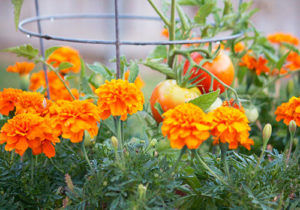
CONSIDER MARIGOLDS & BASIL
Rather than keeping your edibles and your ornamentals separate, why not blend them all together? Marigolds and basil make excellent companion plants to tomatoes, helping to minimize pests like harmful nematodes, and adding beauty and the aroma of fresh herbs to your veggie bed.
Tomatoes need lots of water to produce lots of tasty fruit.
Be sure that you have chosen a good tomato variety for your space: indeterminate tomatoes naturally produce thriving root systems when they have plenty of room, but can become root-bound and require watering multiple times each day if they are in a container or restricted space. Determinate or semi-determinate varieties are better suited to small spaces.
Always water evenly, around the entire circumference of the plant. Avoid splashing water from the soil onto the leaves as much as possible, as splashing increases the likelihood of disease.
In the heat of summer, tomatoes love to sunbathe as much as we do. However, this means that the water in their soil may evaporate much more quickly. Keep a close eye on soil moisture throughout the day and add a surface layer of mulch to hold moisture in.
We recommend fertilizing at planting time, and then following the instructions on your choice of fertilizer until the plant begins to produce fruit. This usually means you will fertilize about 2-3 times with a granular, slow-release organic fertilizer. We carry Dr. Earth, EB Stone, and Hendrikus organic fertilizers that are specifically formulated for veggies and herbs.
Some gardeners may think that a huge, very leafy and rich green colored tomato plant is a sign of a healthy plant. And for the most part, it is. But all leaves and hardly any fruit could be a sign that you have too much nitrogen in your soil. You want a good balance of nutrients so that the plant will produce just enough leaves to support vigorous fruit production. Sticking to a commercial veggie an herb mix like the ones mentioned above is an easy way to take the guess-work out of getting the right balance.
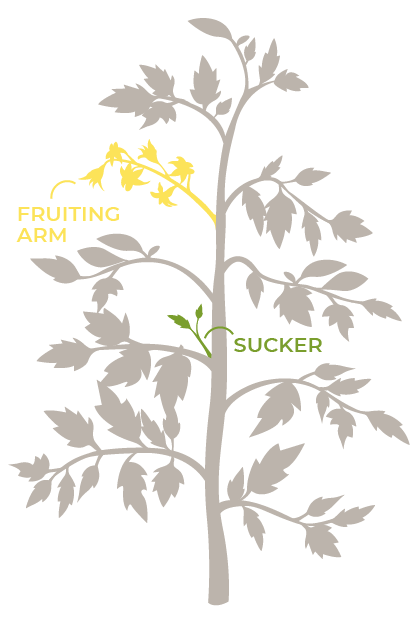 Determinate tomatoes should not be pruned. Indeterminate tomatoes can be pruned, but it isn't usually required for a happy healthy tomato plant. Some gardeners swear by a regular pruning regimen to maximize fruit production, others prefer a more hands-off approach and are happy with the amount of tomatoes produced. Even if you don't want to prune vigorously, thinning out a few leaves on a particularly bushy plant will help with air flow, and reduced risk of disease.
Determinate tomatoes should not be pruned. Indeterminate tomatoes can be pruned, but it isn't usually required for a happy healthy tomato plant. Some gardeners swear by a regular pruning regimen to maximize fruit production, others prefer a more hands-off approach and are happy with the amount of tomatoes produced. Even if you don't want to prune vigorously, thinning out a few leaves on a particularly bushy plant will help with air flow, and reduced risk of disease.
If you do wish to prune your tomato, you can pinch out any suckers that grow between the main stem and the leaf joint (see the illustration above). Towards the end of the season, flowers and immature fruit can be removed so that the plant will focus all of its energy on ripening the most mature fruit.
Plant stress can cause a variety of problems with tomato fruit as it matures. In general you can avoid these altogether by giving your tomatoes plenty of sun, warmth, good air flow, consistent moisture, and balanced nutrients.
Blossom End Rot is a leathery scar or rot on the blossom end of the tomato. It can be caused by uneven watering, insufficient calcium or overly acidic soil. Adding lime to the soil when planting will prevent calcium and acidity problems, but if you want to minimize this for a tomato that may already have a problem, use a calcium correction treatment like Monterey's Foli-Cal.
Catfacing is a puckering of the blossom end of the fruit, with lumps and deep cavities. It is caused by transplanting after fruit develops, or by cool, cloudy weather that makes flowers stick to developing fruit.
Fruit Cracks are radial (circular, around the fruit) cracks caused by too much water or uneven watering when temperatures are high. These conditions promote extremely rapid fruit growth that cracks the surface of the tomato. To avoid this, be sure to water evenly and consistently, particularly during droughts and consider harvesting ripened tomatoes before a bout of summer rain hits.
Sunscald is a sunburn for a tomato, characterized by white or yellow patches that may blister and form a grayish white spot with a dry paper-like surface. Though less common, this may be a sign that there is actually too much sunshine on your tomato fruit.
Common tomato illnesses are mostly fungal diseases that can attack and ruin stressed tomato plants. Each year, we get hundreds of disappointed gardeners asking advice on how to rescue their plant from the clutches of these terrible tomato troubles.
Unfortunately, the only real cure is to prevent them from taking effect in the first place. Most tomato cultivars have been bred with some level of disease resistance but ultimately, it is good care that will make the difference between a healthy plant and a sick one. Growing a healthy tomato is a commitment to consistent watering, maintaining good soil nutrients, and providing lots of sunshine and good air flow.
Another thing to keep in mind: many common diseases are soil borne, so always avoid splashing water from the soil up onto the foliage. You can even remove the lowest leaves on a mature tomato plant if they start to touch the surface of the soil.
If possible, avoid planting tomatoes in the same place for more than a couple of years in a row, and avoid planting tomatoes where you have recently grown other plants in the same family: peppers, eggplants, tomatillos, or potatoes.
If you have a diseased plant, be sure to dispose of the rotted material in the trash at the end of the season. Do not put it into your compost or leave in the ground over winter.
As far as pests go, the best prevention is overall good care: plenty of light and warmth, even watering, balanced fertilizer, and all of that good stuff. A healthy tomato plant can outgrow most pest issues. If you find yourself with a heavy infestation and natural predators don't seem to be handling it, we can help you find the least toxic interventions.
Finding the Perfect Tomato - 2025 List
Tomatoes are here!!
CAUTION! Wait for nighttime temps to be above 50 degrees (F) before planting outside without protection to avoid cold damage and poor fruit production.
(Weekly rotating selection). If your favorite is on this list, but is not available when you come into Sky, it will likely be back soon. Additional varieties available on a rotating basis. List Updated 04/18/25
| Azoychka | Beefsteak | Heirloom | Indet | Yellow | 70 | Up to 1 lb, dense, lobed fruit, balance of sweet & citrusy flavor, good acid balance, Russian heirloom |
| Beefsteak | Beefsteak | Heirloom | Indet | Red | 80 | 1lb, dense fruit with soft skin. Sweet rich flavor. Classic since 1890 |
| Berkeley Tie-Dye | Beefsteak | Open Pol | Indet | Striped pink/green | 70 | 12 oz, dense fruit with complex flavor. Kaleidoscope interior! Sturdy compact plants |
| Better Boy | Beefsteak | Hybrid | Indet | Red | 70 | Deep red. 12-16 oz. fruit is juicy and meaty with classic flavor. Extremely productive, disease resistant vines. |
| Big Beef | Beefsteak | Open Pol | Indet | Red | 75 | Up to 1 lb, classic flavor. OP version of popular hybrid. Vigorous, cold tolerant, disease resistant plants |
| Big Brandy | Beefsteak | Heirloom cross | Semi-Det | Red | 75 | 12-15 oz, deeply lobed fruit with balanced flavor. The best of 'Brandywine' & 'Big Dwarf', plus hybrid vigor. Compact plant |
| Black Krim | Beefsteak | Heirloom | Indet | Black/burgundy purple with green shoulders | 85 | 12 oz fruit with rich, complex flavor and a hint of saltiness. Dense & juicy. Russian heirloom from Crimea |
| Brandywine | Beefsteak | Heirloom | Indet | Red pink | 85 | Up to 7" across, lobed. Classic 19th century heirloom; standard-setter for complex flavor. Needs warmth and sun to ripen |
| Brandywine, Yellow | Beefsteak | Heirloom | Indet | Yellow | 85 | Up to 7" across, lobed. Golden yellow version of classic favorite |
| Caspian Pink | Beefsteak | Heirloom | Indet | Pink | 80 | Brandywine-like size and flavor, but ripens better in cool growing conditions |
| Chef's Choice Bicolor | Beefsteak | Hybrid | Indet | Yellow with red-streaked flesh | 75 | 8 oz. meaty fruit with sweet-savory flavor and great texture. Productive, disease resistant plant |
| Chef's Choice Black | Beefsteak | Hybrid | Indet | Brown, black, and dark green shades | 75 | 8-10 oz fruit is juicy and sweet with rich flavor. Productive, disease resistant plant |
| Chef's Choice Green | Beefsteak | Hybrid | Indet | Green with yellow streaks | 90 | 10 oz meaty fruit with sweet citrus flavor and great texture. Pick while firm. Productive, disease resistant plant |
| Chef's Choice Orange | Beefsteak | Hybrid | Indet | Orange | 75 | 9-12 oz fruit has glowing orange skin and flesh. Holds color when cooked. Rich tropical flavor. Productive & disease resistant |
| Chef's Choice Pink | Beefsteak | Hybrid | Indet | Deep pink | 75 | 10-16 oz meaty fruit with perfect sweet-tart balance, great texture and flavor. Productive, disease resistant plant |
| Chef's Choice Purple | Beefsteak | Hybrid | Indet | Purple shoulders, red base | 80 | 10-oz meaty fruit with rich flavor. Firm, smooth fruit. Productive, disease resistant plant |
| Chef's Choice Red | Beefsteak | Hybrid | Indet | Red | 85 | 6" fruit with classic flavor, excellent sweet-acid balance. Productive, disease resistant plant |
| Chef's Choice Yellow | Beefsteak | Hybrid | Indet | Yellow | 90 | 10 oz meaty fruit with sweet citrus flavor and great texture. Productive, disease resistant plant |
| Cherokee Purple | Beefsteak | Heirloom | Indet | Dark pink/purple with dusky shoulders | 80 | Up to 1 lb, dense fruit. Dark pink with dusky shoulders. Delicious rich flavor |
| Cosmonaut Volkav | Beefsteak | Heirloom | Semi-det | Red with yellow shoulders | 70 | 1 lb fruit. Prized Russian heirloom. Balanced and complex flavor, dense texture. Early. Ripens in cool conditions. |
| Goliath | Beefsteak | Heirloom | Indet | Red | 85 | 1 lb or larger sweet, tasty fruit. High yields with good sun and heat, one slice covers a sandwich. |
| Kellogg's Breakfast | Beefsteak | Heirloom | Indet | Orange juice colored flesh | 85 | 1-2 lb fruit with few seeds. Meaty, with rich, sweet flavor with a bit of tanginess. |
| Mortgage Lifter | Beefsteak | Heirloom | Indet | Red with pink skin | 85 | 1-2 lb fruit with few seeds. Rich, sweet flavor. Popular since the 1930s, when they paid their breeder’s mortgage. Good yields |
| Paul Robeson | Beefsteak | Heirloom | Indet | Dark brick red with green shoulders | 80 | Up to 4" fruit, Slightly flattened shape. Distinctive sweet and smoky flavor. Russian heirloom from Siberia |
| Persimmon | Beefsteak | Heirloom | Indet | Golden-yellow | 80 | 1-2 lb fruit with a great flavor. Reliable and productive. Does well in the Northwest |
| Pineapple | Beefsteak | Heirloom | Indet | Yellow with red stripes | 85 | Huge fruit, up to 2 lbs. Tasty, tropical flavor |
| Black Prince | Slicing/Paste | Heirloom | Indet | Dark garnet black/purple | 70 | 3-5 oz siberian heirloom, performs well in cool climates. Slightly oblong fruit. Rich, sweet flavor. |
| Black Sea Man | Slicing | Heirloom | Determ | Mahogany black with olive green shoulders | 75 | 4-8 oz lobed fruit. Intense rich flavor. Prolific and unusual |
| Bloody Butcher | Slicing | Open Pol | Indet | Bright red | 55 | 4 oz fruit grows in large clusters. Juicy with good, balanced flavor, especially delicious for an extra-early tomato. |
| Carbon | Slicing | Heirloom | Indet | Black/dark purple | 90 | 8-12 oz fruit. Exceptionally sweet, complex flavor. |
| Celebrity | Slicing | Hybrid | Determ | Red | 70 | 7-8 oz. firm, globe-shaped fruit. Does well in Pacific NW. Mild flavor. Crack and disease resistant. |
| Champion | Slicing | Hybrid | Indet | Red | 70 | 6-8 oz fruit. Juicy and dense with few seeds. Sweet flavor. Excellent for sandwiches. Disease resistant. |
| Costoluto Genovese | Slicing | Heirloom | Indet | Red | 75 | Ribbed, firm, fleshy fruits up to 7 oz. Fine sweet flavor. Great for slicing, but meaty enough to make sauce. Like a small beefsteak. |
| Czech Excellent Yellow | Slicing | Heirloom | Indet | Yellow | 70 | 3" round fruit. Sweet and mild with a touch of tartness. Good producer |
| Dona | Slicing | Heirloom | Indet | Red | 65 | Small, round fruit. French variety bred for great acid/sugar balance and excellent flavor |
| Early Girl | Slicing | Hybrid | Indet | Red | 60 | 4-6 oz fruit. Classic favorite starts early and keeps going all season. Good early tomato flavor. Disease resistant. |
| First Lady II | Slicing | Hybrid | Indet | Red | 55 | Medium-sized, early-ripening slicer. An Early Girl cross bred for improved disease resistance. |
| Fourth of July | Slicing | Hybrid | Indet | Red | 49 | 4 oz round fruit. Extra early Burpee introduction |
| French Carmello | Slicing | Hybrid | Indet | Red | 75 | 8-10 oz, dense fruit with delicious balanced flavor, disease and crack resistance, and high yields. Popular French market variety. |
| Genuwine | Slicing | Heirloom cross | Indet | Red | 70 | 10-12 oz fruit. Best of ‘Brandywine’ and ‘Costoluto Genovese,’ plus hybrid vigor. Delicious and much earlier than either parent. |
| Glacier | Slicing | Open Pol | Semi-Det | Red/orange | 55 | 2 ½” ultra early fruit. Very sweet. Sprawling, open, growth habit, 2 ½ - 3 ½ feet across. |
| Goliath Bush | Slicing | Hybrid | Determ | Red | 70 | 6-8 oz classic round on a compact, 3-4’ plant. Good disease resistance. Prolific production. Sweet flavor. |
| Green Zebra | Slicing | Heirloom | Indet | Striped light & dark green | 80 | 6 oz tasty fruit. Unique! One of the best green varieties for this area |
| Japanese Black Trifele | Slicing | Heirloom | Indet | Mahogany red with green shoulders | 85 | 6 oz pear-shaped fruit, rich, complex flavor. Unique and delicious. Prolific. Crack resistant. |
| Jaune Flammé | Slicing | Heirloom | Indet | Apricot orange | 75 | 4 oz fruit in clusters. Complex, fruity flavor. Good fresh or dried. Relatively compact vines. Prolific. |
| Langley's Silver Tiger | Slicing | Hybrid | Indet | Red with orange stripes | 72 | 2-4 oz fruit that is early and prolific. Silvery foliage. Bred by Langley's Fine Gardens |
| Lemon Boy | Slicing | Hybrid | Indet | Yellow | 70 | 6-7 oz fruit with sweet, low-acid flavor. Disease resistant and productive plant |
| Momotaro | Slicing | Hybrid | Indet | Reddish pink | 65 | 6-7 oz. sweet fruit with crack-resistant skin. Most popular tomato in Japan |
| Moonglow | Slicing | Open Pollinated | Indet | Bright orange | 85 | 2" globe-shaped dense, meaty fruit with a sweet, rich flavor. Stores well |
| Moskvich | Slicing | Heirloom | Indet | Red | 60 | 4-6 oz. tomatoes with delicious, rich flavor. Early Russian heirloom that can set fruit in cool weather. Crack resistant. |
| New Girl | Slicing | Hybrid | Indet | Red | 59 | 4-6 oz fruit. Very similar to Early Girl but even better flavor and disease resistance. |
| Oregon Spring | Slicing | Open Pol | Determ | Red | 70 | 6-7 oz, oval-shaped fruit. Very cold-tolerant variety developed at OSU. Mild and sweet flavor with few seeds. |
| Rose de Berne | Slicing | Heirloom | Indet | Rose-pink | 75 | 4-8 oz, round, smooth soft skin. Rich flavor, nice sweet-acid balance. Swiss heirloom. |
| Siletz | Slicing | Hybrid | Determ | Red | 70 | 12 oz, dense, few seeds. Good, balanced flavor. Larger, improved ‘Oregon Spring.’ Cold tolerant. Disease resistant. |
| Stupice | Slicing | Heirloom | Indet | Red | 60 | 4 oz fruit with excellent, balanced flavor. Resilient, productive, very cold-tolerant. Czech heirloom. Ciscoe Morris' favorite! |
| Taxi | Slicing | Open Pol | Determ | Bright yellow | 75 | 4-6 oz fruit with very sweet, low-acid flavor. Prolific early-season production over a 3-4 week period. Adaptable, resilient plants. |
| Tigerella | Slicing | Heirloom | Indet | Red with yellow-orange stripes | 65 | 4-6 oz fruit is tangy and a little sweet. English heirloom. |
| Valencia | Slicing | Heirloom | Indet | Deep orange | 75 | Smooth, round 8 oz fruit. Grows well in cool climate. |
| Yellow Perfection | Slicing | Heirloom | Indet | Lemon yellow | 75 | Gold ball shaped fruit with sensational flavor. Prolific producer |
| Amish Paste | Sauce/Paste | Heirloom | Indet | Red | 80 | 8-12 oz dense, meaty fruit with few seeds. Excellent rich and sweet flavor. Juicy and delicious fresh; fantastic for sauce. |
| Anna's Russian | Sauce/Paste | Heirloom | Indet | Pink-red | 75 | Up to 1 lb heart-shaped, dense fruit. Rich, sweet, and complex flavor. Delicious fresh or in sauce. |
| Banana Legs | Sauce/Paste | Heirloom | Determ | Bright yellow | 75 | 4" long fruits are dense and sweet. Prolific; prolonged harvest |
| Cherry Roma | Sauce/Paste | Heirloom | Indet | Red | 75 | Plum-shaped, 1" fruit, great fresh or dried. |
| Giant Oxheart | Sauce/Paste | Heirloom | Indet | Rose-pink | 90 | Up to 2 lb dense fruit. Great flavor of a typical oxheart variety |
| Green Grape | Sauce/Paste | Heirloom | Determ | Lime green | 65 | Rich, sweet, zingy flavor. Originally bred for green catsup. Good for snacking. |
| Heinz 2653 | Sauce/Paste | Open Pol | Determ | Red | 75-80 | Perfect canning tomato. Ripens all at once on compact upright plants |
| Hungarian Heart | Sauce/Paste | Heirloom | Indet | Red | 85 | Giant, 1b heart-shaped fruit. Excellent for paste, sauce, or fresh eating. Rich flavor. Dense texture; few seeds. Productive. |
| Marzinera | Sauce/Paste | Heirloom cross | Indet | Red | 70 | The best of ‘San Marzano’ and ‘Cream Sausage,’ plus hybrid vigor. Very productive, with exceptionally rich flavor. |
| Paisano | Sauce/Paste | Hybrid | Determ | Red | 75 | 3 oz sweet fruit. Especially abundant production |
| Principe Borghese | Sauce/Paste | Heirloom | Determ | Red | 75 | Plum-shaped, meaty, with little juice and few seeds. Bred specifically for drying, also makes good sauce. Prolific yields, good flavor. |
| Roma | Sauce/Paste | Heirloom | Determ | Red | 75 | Classic large Italian paste tomato. Thick walls and low moisture content. Good fresh, cooked, or made into sauce. |
| Salvaterra's Select | Sauce/Paste | Heirloom | Indet | Red | 70 | 2.5" - 3.5" plum-shaped fruit. Sweet and meaty; great for salsa |
| San Marzano | Sauce/Paste | Heirloom | Indet | Red | 80 | Up to 5” long fruit. Italian heirloom, and a classic for rich and flavorful sauces. Small seed cavity with few seeds. |
| Super Roma | Sauce/Paste | Hybrid | Determ | Red | 75 | Hybrid version of 'Roma' with larger fruits and improved disease resistance. Good flavor. Perfect for tomato sauce |
| Viva Italia | Sauce/Paste | Hybrid | Determ | Red | 85 | Hybrid version of 'Roma' with improved production and disease resistance. Good flavor. Perfect for tomato sauce |
| Black Cherry | Cherry | Open Pol | Indet | Mahogany black/purple | 70 | 1” beautiful fruit on vigorous plants. Sweet, rich, complex flavor that rivals full-sized purple heirlooms. Prolific. |
| Blondköpfchen | Cherry | Heirloom | Indet | Golden yellow | 75 | 1” fruit in giant clusters. Translates to “little blond girl.” Cold-tolerant German heirloom. Exceptionally sweet and crack-resistant. |
| Bumblebee | Cherry | Hybrid | Indet | Striped, color varies | 70 | Unique 1” tomatoes with complex, mellow flavor. Each fruit boasts a different pattern of contrasting vertical stripes |
| Chocolate Cherry | Cherry | Open Pol | Indet | Black/brown port wine color | 70 | 1” fruit. Rich, sweet, and complex flavor. Vines are relatively compact. Crack-resistant. Holds well on vine, and can ripen off the vine. |
| Galinas | Cherry | Heirloom | Indet | Golden yellow | 75 | Quarter-sized fruit in giant clusters. Sweet, rich, complex flavor. Sprawling productive plants |
| Isis Candy | Cherry | Heirloom | Indet | Red & golden yellow marbling | 70 | 1” fruit with complex, rich and fruity flavor. Prolific production. |
| Midnight Snack | Cherry | Hybrid | Indet | Bright red with indigo overlay | 70 | Trusses of 1 ½” fruit with great flavor and antioxidant content. Productive. |
| Orange Paruche | Cherry | Hybrid | Indet | Glowing orange | 70 | 1” fruit. Extremely sweet and flavorful. |
| Riesentraube | Cherry | Heirloom | Indet | Red | 75 | Clusters of 20-40 1.5" fruit. The name is German for "cluster of grapes." Sweet, complex flavor |
| Sugar Lump | Cherry | Heirloom | Indet | Red | 60 | 1” fruit in large clusters. One of the sweetest cherry tomatoes ever. Vigorous and productive. German heirloom. |
| Sungold | Cherry | Hybrid | Indet | Golden orange | 65 | 1” fruit. Exceptionally sweet, complex, and fruity flavor. Disease resistant. Very prolific. Thin skinned. Prone to cracking. |
| Sunsugar | Cherry | Hybrid | Indet | Orange | 60 | Similar to ‘Sungold,’ but with improved crack resistance and slightly thicker skin. Some prefer one, some the other. |
| Sweet Aperitif | Cherry | Open Pol | Indet | Red | 80 | Dime sized fruit with sweet, complex winey flavor and tropical aroma. Crack resistant. Productive and vigorous vines. |
| Sweet Baby Girl | Cherry | Hybrid | Indet | Bright red | 70 | Sweetest red cherry, lots of fruit on a 1/2 size plant. Great for greenhouses. Crack resistant. |
| Sweet 100 | Cherry | Hybrid | Indet | Red | 70 | Very similar to ‘Sweet 100,’ but with better disease and crack resistance. Some prefer the classic version, some prefer this one. |
| Sweet Million | Cherry | Hybrid | Indet | Bright red | 70 | 1” cherry tomato. Very sweet and extremely prolific. Fruit grows in long trusses. Vigorous vines. A classic favorite. |
| Washington Cherry | Cherry | Heirloom | Indet | Red | 60 | Heavy producer of large, globe-shaped cherry tomatoes. Crack resistant; keeps well. Cold tolerant |
| Lemon Drop | Currant | Open Pol | Indet | Bright lemon yellow | 70 | ½-¾” fruit. Refreshing, bright and sweet flavor. Prolific production. Performs well in cool weather. |
| Matt's Wild Cherry | Currant | Heirloom | Indet | Deep red | 65 | ½”, exceptionally flavorful fruit with extremely vigorous vines. Said to be similar to a wild variety from Mexico. |
| Red Currant | Currant | Open Pol | Indet | Red | 75 | ½” fruit packed with sweet and complex flavor grows in big clusters. Vigorous, sprawling vines: give them plenty of space! |
| Yellow Currant | Currant | Open Pol | Indet | Golden yellow | 70 | Currant tomatoes full of flavor. Beautiful mixed with red currants. Vigorous, sprawling vines. |
| Jelly Bean, Red | Grape | Hybrid | Indet | Bright red | 70 | Small, juicy, sweet and flavorful. Crack and disease resistant. |
| Jelly Bean, Yellow | Grape | Hybrid | Indet | Bright yellow | 75 | Small, juicy, sweet and flavorful. Crack and disease resistant. |
| Juliet | Grape | Hybrid | Indet | Red | 60 | 2” long by 1” wide. Delicious fresh, dried, or in sauce. Excellent sweet, rich flavor. Crack and blight resistant. Holds well on vine. |
| Pink Tiger | Grape | Open Pol | Indet | Dark pink with orange stripes | 70 | 2" long fruit that tapers to a point. Well-balanced acidic yet sweet flavor |
| Valentine | Grape | Hybrid | Indet | Red | 60 | Cross bred with wild tomato strain for super high lycopene content, intense flavor, and high yield. Harvest when deep red for best flavor. Resistant to blight. |
| Yellow Grape | Grape | Open Pol | Indet | Yellow | 68 | Clusters of sweet, mild, golden fruit. Low acid. Vigorous and productive vines |
| Yellow Pear | Pear | Heirloom | Indet | Yellow | 75 | Hundreds of 1-2” fruit on large vigorous vines. Sweet and mild, non-acid flavor. A classic. |
| Gold Nugget | Cherry/Container | Hybrid | Determ | Golden orange | 55 | ¾” fruit. Prolific early-season production. Sets fruit in cool weather. Rich, sweet flavor. Thin yet crack-resistant skin. Bred at OSU. |
| Oregon Cherry | Cherry/Container | Open Pol | Determ | Red | 60 | 1”, sweet and thin-skinned fruit on plants just 1.5’ tall. Perfect for patio containers and small spaces! Developed at OSU. |
| Ruby Crush | Grape/Container | Hybrid | Determ | Scarlet | 65-70 | 1.5” long sweet, fruit. Productive, compact plant for containers |
| Tumbler AKA Tumbling Tom Red | Cherry/Container | Hybrid Dwarf | Determ, Trailing | Red | 70 | 1¼” sweet fruit that hangs on compact plants rather than climbs; Great for hanging baskets. |
| Tumbling Tom Yellow | Cherry/Container | Hybrid Dwarf | Determ, Trailing | Yellow | 70 | 1¼” sweet fruit that hangs on compact plants rather than climbs; Great for hanging baskets |
| Almadine | Super Dwarf | Hybrid | Determ | Dark red-pink with purple shoulders | 95 | Paste/sauce tomato similar to Roma. Pleasant, balanced flavor. Prolific |
| Beauty King | Super Dwarf | Hybrid | Indet | Red with gold speckles & stripes | 75 | Large slicer; gorgeous 6-12 oz round fruit. Sweet rich flavor |
| Chocolate Lightning | Super Dwarf | Hybrid | Indet | Brown with gold & green streaks | 79 | Slicer; 4-8 oz fruit with rich intense flavor. Sturdy 4'+ plants need staking. Prolific |
| Hannah's Prize | Super Dwarf | Hybrid | Indet | Red | 75 | Large slicer; flattened 6-12 oz fruit. Very nice well-balanced, slight tart flavor. Excellent yields |
| Lemon Ice | Super Dwarf | Hybrid | Indet | Lemon yellow | 70 | Small slicer; heart-shaped 4-6 oz fruit. Dense sweet flesh with excellent flavor. 3' tall plants with wispy leaves |
| Pink Passion | Super Dwarf | Hybrid | Indet | Crimson pink | 65 | Slicer; heart-shaped medium-sized fruit. Sweet well-balanced flavor. Excellent yields |
| Rosella Crimson | Super Dwarf | Hybrid | Indet | Crimson pink | 78 | Beefsteak; flattened 6-12 oz fruit is sweet, juicy, & flavorful. Excellent yields |
| Rosella Purple | Super Dwarf | Hybrid | Indet | Purple-pink | 75 | Beefsteak; fruit similar to Cherokee Purple. Intense, balanced sweet, acid, & umami flavors. Stocky 3-4' plant |
| Sweet Scarlet Dwarf | Super Dwarf | Hybrid | Indet | Scarlet | 85 | Large slicer; smooth, flattened 6-16 oz fruit. Outstanding flavor! Excellent yields. Some plants may yield orange fruit |
| Tasmanian Chocolate | Super Dwarf | Hybrid | Indet | Mahogany red | 60 | Beefsteak; fruit similar to 'Paul Robeson' with a sweet full flavor. Stocky 3-4' plant |
| Yukon Quest | Super Dwarf | Hybrid | Determ | Crimson pink | 60 | Flattened round fruit with sweet, well-balanced flavor. Stocky 3' plant. Prolific producer. |
